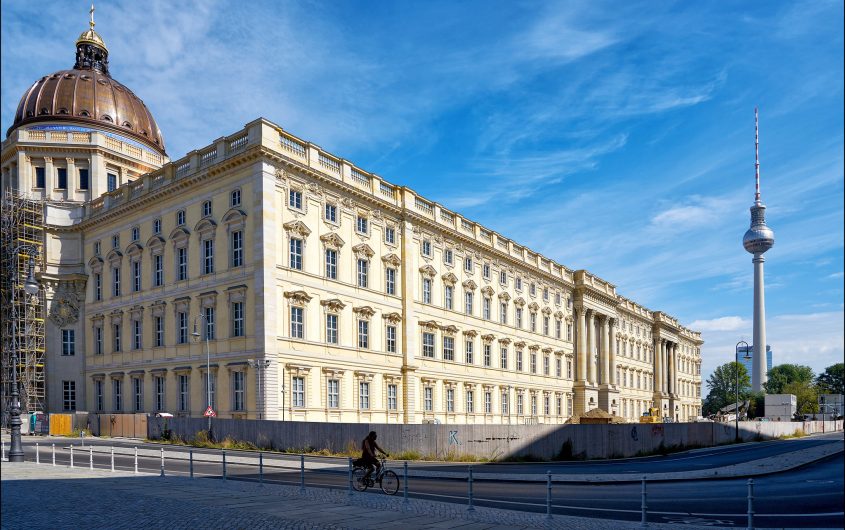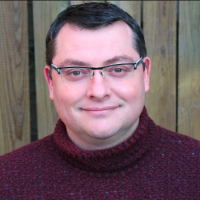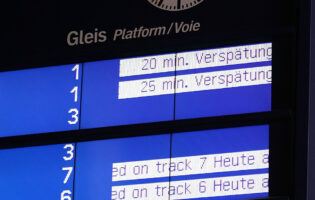
micharl_foto via Flickr
The Anticlimactic Opening of the Humboldt Forum

Eric Langenbacher
Senior Fellow; Director, Society, Culture & Politics Program
Dr. Eric Langenbacher is a Senior Fellow and Director of the Society, Culture & Politics Program at AICGS.
Dr. Langenbacher studied in Canada before completing his PhD in Georgetown University’s Government Department in 2002. His research interests include collective memory, political culture, and electoral politics in Germany and Europe. Recent publications include the edited volumes Twilight of the Merkel Era: Power and Politics in Germany after the 2017 Bundestag Election (2019), The Merkel Republic: The 2013 Bundestag Election and its Consequences (2015), Dynamics of Memory and Identity in Contemporary Europe (co-edited with Ruth Wittlinger and Bill Niven, 2013), Power and the Past: Collective Memory and International Relations (co-edited with Yossi Shain, 2010), and From the Bonn to the Berlin Republic: Germany at the Twentieth Anniversary of Unification (co-edited with Jeffrey J. Anderson, 2010). With David Conradt, he is also the author of The German Polity, 10th and 11th edition (2013, 2017).
Dr. Langenbacher remains affiliated with Georgetown University as Teaching Professor and Director of the Honors Program in the Department of Government. He has also taught at George Washington University, Washington College, The University of Navarre, and the Universidad Nacional de General San Martin in Buenos Aires, Argentina, and has given talks across the world. He was selected Faculty Member of the Year by the School of Foreign Service in 2009 and was awarded a Fulbright grant in 1999-2000 and the Hopper Memorial Fellowship at Georgetown in 2000-2001. Since 2005, he has also been Managing Editor of German Politics and Society, which is housed in Georgetown’s BMW Center for German and European Studies. Dr. Langenbacher has also planned and run dozens of short programs for groups from abroad, as well as for the U.S. Departments of State and Defense on a variety of topics pertaining to American and comparative politics, business, culture, and public policy.
__
December will witness one of Germany’s (actually, Europe’s) biggest cultural events in at least a decade: the opening of a massive new museum and cultural complex in the heart of Berlin, the Humboldt Forum. Costing over €700 million and containing 183,000 square feet, several museums such as the Asian art and ethnological museums (both formerly in Dahlem) will reopen in the new space. Besides temporary exhibition space, there will also be a section on Berlin and its connections to the world and the Humboldt Lab that will explore the interconnections of natural and social systems. Located in the very center of the city across from the cathedral and Museum Island, the building is mainly an external reconstruction of the famed palace of the Hohenzollern monarchs, although one façade is modern as are all the interior spaces.
But, instead of anticipation and celebration, there is controversy. Of course, this is Germany after all—and Berlin specifically. No big project, especially a cultural project, is uncontroversial these days. The Elbphilharmonie in Hamburg was seven years late and cost four times original estimates. It took fifteen years to build the Memorial to the Murdered Jews of Europe—and about as long to create a permanent structure at the Topography of Terror. The Memorial to Freedom and Unity in front of the reconstructed Berlin palace only broke ground in May 2020 after twenty-two years of discussion and planning.
The degree of acrimony over the Humboldt Forum project is in a class by itself. There are at least two reasons for the depth of the controversy, but as is so often the case, Germans’ fraught relationship to their history hovers over everything. I will cover the first set of controversies revolving around the building in this article. A future article will tackle the debates about the contents, particularly the ethnographical museum, which is part of a larger European debate about the period of imperialism and the artifacts dating to that part of history.
The Building
The first bone of contention has been the building. For hundreds of years, this was the site of the Berlin Palace (Berliner Schloss—although often called the City Palace, Stadtschloss, this was apparently a very recent usage). The main structure was constructed in baroque style in the early eighteenth century by the architect Andreas Schlüter, including the esteemed courtyard, the Schlüterhof, although some parts of the late medieval and renaissance structures were retained. A copper-clad dome was added on the western side around 1850. Interiors were a mixture of baroque and neoclassical styles and included the grand staircase, Rittersaal (knight’s hall), and palace chapel under the dome. Housing the Prussian kings and then German emperors, it became a museum during the Weimar Republic. Bombed and burnt in WWII, much had survived and it was widely expected to be reconstructed after the war.
Unluckily, the building was located in East Berlin. After the founding of the German Democratic Republic in 1949, communist leader Walter Ulbricht decided that the ruins would be demolished, that this symbol of feudalism and oppressive monarchy should be destroyed—despite massive criticism from across the country and world due to the building’s historical and architectural significance. As the party newspaper Neues Deutschland put it “nothing should remind us of the inglorious past.”[1] The demolition was completed by the end of 1950. For over twenty years the massive space was used for party demonstrations, but then from 1973-1976, the colossal Palast der Republik was constructed with its distinctive eastern European modernist style replete with its orange-copper colored windows. Housing the East German “parliament” (Volkskammer) there was also a variety of event and leisure spaces such as a bowling alley that many East Germans utilized and remembered fondly.
After reunification, there was much debate about what to do with the now-redundant building, which was also riddled with hazardous asbestos. Very early on, an initiative was launched to re-construct the palace building, including an initiative in 1993 that covered the Palast with a replica banner of the Schloss’s facade. Over a decade of debate—which also witnessed the Palast gutted to remove the asbestos—resulted in the Bundestag resolving in 2002 to rebuild the original Schloss, buttressed by private donations (totaling over €100 million currently). The Palast was dismantled from 2006 to 2008 and construction of the Schloss took place from 2013 to 2020.
The Debates
Each step on the way to the present was hugely controversial. First, many easterners in Berlin and elsewhere wanted to retain the Palast der Republik. There was more than a little nostalgia, the much-cited Ostalgie, with the dismantling of the communist structure becoming yet another example of Westerners literally bull-dozing their history and heritage. Many argued that the Palast was not a noxious symbol of the East German system, but rather showed its good side—with the event spaces, restaurants, and even the Volkskammer predominantly associated with it. These critics made thought-provoking points about the retention of history and the built reminders of that particular past.
Others derided the decision to reconstruct the Schloss’s facades (on three sides). Even though there has been a marked trend throughout Germany in recent years to reconstruct some of what was lost in WWII and its aftermath—the Frauenkirche and Neumarkt area in Dresden are renowned, but there is also the Dom-Römer area in Frankfurt, the palace in Braunschweig (half museum and half shopping mall), Schloss Herrenhausen in Hannover, and numerous buildings, currently the tower of the Garnisonkirche, in Potsdam—and many more. Critics deride these projects as efforts to expunge history, to forget the destructive consequences of Germany’s twentieth century, or as historical fantasies, un-authentic versions of Disneyland. From this perspective, once a building is gone, something contemporary must take its place—although few make this point about Notre Dame in Paris, Windsor Castle, or La Fenice in Venice. Some even go so far as to connect the trend toward reconstruction to the rehabilitation and growth of right-populist, right-radical, and nationalistic positions. And as always, there are the good German taxpayers who decry the large cost of the project.
Some of the less hyperbolic arguments do resonate. Easterners do, legitimately, have the right to their fond memories of the Palast der Republik. The dilemma of what historical buildings to preserve as reminders about different pasts can probably never be satisfactorily solved. For me, however, I have always strongly supported the historical reconstruction of the Schloss. Above all, it is simply a beautiful building that anchors and complements the old center of Berlin. I would not want the arbitrary decision of the odious Ulbricht to have the last architectural word.
Moreover, given the sheer destruction of WWII (deserved or not) I do not think it is unhealthy for Germans to want some connections to their more distant past. Efforts to reconstruct noteworthy buildings are not always about attempts to forget the country’s murderous twentieth century, whitewashing history, or glorifying some mythical yet sanitized Prussia. Rather, one could argue that it is about a fuller historical consciousness, where all aspects of history and the built environment find their space—especially in light of the many East German buildings that remain and the overwhelming modernism in German cities, particularly Berlin.
[1] “es soll uns nichts mehr an unrühmlich Vergangenes erinnern.”









